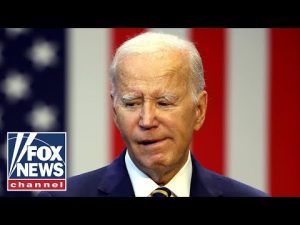In the world of international trade politics, every play and counter-play can feel like a high stakes chess game. Recently, President Trump has been at the forefront of an engaging economic situation with none other than the European Union. The talks are centered around a trade deal that hangs by a mere thread of chance — or as some might put it, a coin flip’s chance of success. With the EU’s current tariffs sitting pretty at a hefty 30%, they seem rather eager to strike a deal, and one can only imagine how much they’re itching to have something pan out in their favor.
Wall Street, our ever-dependable barometer of economic health — if not a tad bit dramatic at times — has reacted with a burst of optimism. Yes, the stock market closed with record highs last Friday, giving a nod of approval to the ongoing trade discussions with both Europe and China. It seems Wall Street’s nerves have been calmed, at least for now. Even with the Federal Reserve still pondering over interest rates, which has vexed President Trump to no end, the market remains buoyant. Perhaps Wall Street has finally gotten used to the tempestuous tango between tariffs and tweets.
Critics of these trade policies — or should we say, the doomsayers predicting a tariff-induced apocalypse — have not seen their predictions materialize, much to their dismay. The former Democratic president had warned of a recession due to the tariffs, conjuring images of chaos and economic collapse. Despite such pessimistic forecasts, here we are, not only surviving but thriving. It seems economic resilience is not something to be underestimated, much like the persistence of a certain few who continue to harp on about incoming disasters.
When one looks at the numbers, especially the GDP forecasts, it’s clear that the economy isn’t quite in dire straits. While the first quarter didn’t paint the rosiest of pictures, with consumers rushing to outpace the tariffs, experts noted this as a quirk rather than a trend. The second quarter shows more promising figures, and economists seem to be optimistic about continued growth. Even the trendy term “dead cat bounce” can’t dim the long-term outlook as it seems we’re on track for a stable growth curve.
Lastly, let’s touch on the cherry on top of this economic debate: the revenue from these tariffs. It may surprise some to learn that the estimated $300 billion in annual revenue isn’t a trivial sum to dismiss. Critics may flail and fume over perceived deficits, but simple arithmetic appears to elude them. Over the next decade, these tariffs, along with Trump’s commendable tax cuts, should balance out to a stable fiscal policy. In the grand scheme of economic ups and downs, it looks like we’ll be cruising steadily along. There’s something to be said for not getting jumpy at every fluctuation on Wall Street or at every proclamation from those who haven’t quite grasped that the sky isn’t falling, much to their dismay.







